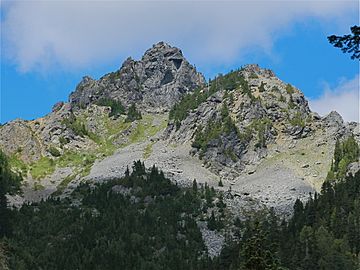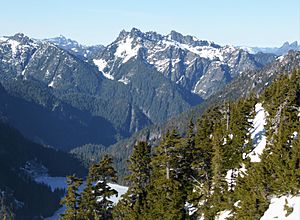Malachite Peak facts for kids
Quick facts for kids Malachite Peak |
|
|---|---|

Malachite Peak
|
|
| Highest point | |
| Elevation | 6,261 ft (1,908 m) |
| Prominence | 1,261 ft (384 m) |
| Isolation | 3.66 mi (5.89 km) |
| Parent peak | Camp Robber Peak (6,286 ft) |
| Geography | |
| Location | King County Washington state, U.S. |
| Parent range | Cascade Range |
| Topo map | USGS Big Snow Mountain |
| Climbing | |
| First ascent | 1937 |
| Easiest route | class 3 scrambling |
Malachite Peak is a mountain in Washington state, U.S. It stands about 6,261 feet (1,908 meters) tall. This peak is located in eastern King County, about 5.5 miles (8.9 km) south of Skykomish.
Malachite Peak is part of the Cascade Range. It sits one mile north of Lake Malachite. This area is within the Alpine Lakes Wilderness. The land is managed by the Mount Baker-Snoqualmie National Forest. Water from the mountain flows into streams that feed the Skykomish River.
The closest taller mountain is Camp Robber Peak, which is about 3.66 miles (5.89 km) to the south. People believe the first time someone climbed Malachite Peak was in 1937. This climb was likely done by a team from the United States Geological Survey (USGS). The USGS named the peak around 1975. They named it after a survey marker called "Malachite."
Understanding the Climate Around Malachite Peak
Malachite Peak is in a "marine west coast" climate zone. This means it gets a lot of influence from the ocean. Most weather systems start over the Pacific Ocean. They then move northeast towards the Cascade Mountains.
When these weather systems reach the Cascades, the mountains force the air upward. This process is called orographic lift. As the air rises, it cools and drops its moisture. This causes a lot of rain or snow to fall on the western side of the Cascades.
Because of this, the west side of the Cascades gets a lot of precipitation. This is especially true in winter, when most of it falls as snow. During winter, the weather is often cloudy. However, in summer, high-pressure systems over the Pacific Ocean often bring clear skies. The snow here tends to be wet and heavy. This can create a high risk of avalanches.
How Malachite Peak Was Formed: Geology
The Alpine Lakes Wilderness has very rugged land. It features sharp peaks, rocky ridges, and deep valleys carved by glaciers. There are also many granite walls and over 700 mountain lakes. The different shapes of the land and big changes in elevation were created by geological events. These events happened millions of years ago.
The Cascade Range began forming millions of years ago. This was during the late Eocene Epoch. At that time, the North American Plate was slowly moving over the Pacific Plate. This movement caused many periods of volcanic activity. Also, small pieces of the Earth's crust, called terranes, helped create the North Cascades. This happened about 50 million years ago.
Later, during the Pleistocene period (over two million years ago), glaciers played a big role. These huge sheets of ice moved forward and backward many times. They carved and shaped the landscape. The last time glaciers retreated from the Alpine Lakes area was about 14,000 years ago. They had moved north of the Canada–US border by 10,000 years ago.
The river valleys in this area have a "U" shape. This shape is a direct result of that recent glaciation. The main processes that created the tall peaks and deep valleys of the Alpine Lakes Wilderness are:




